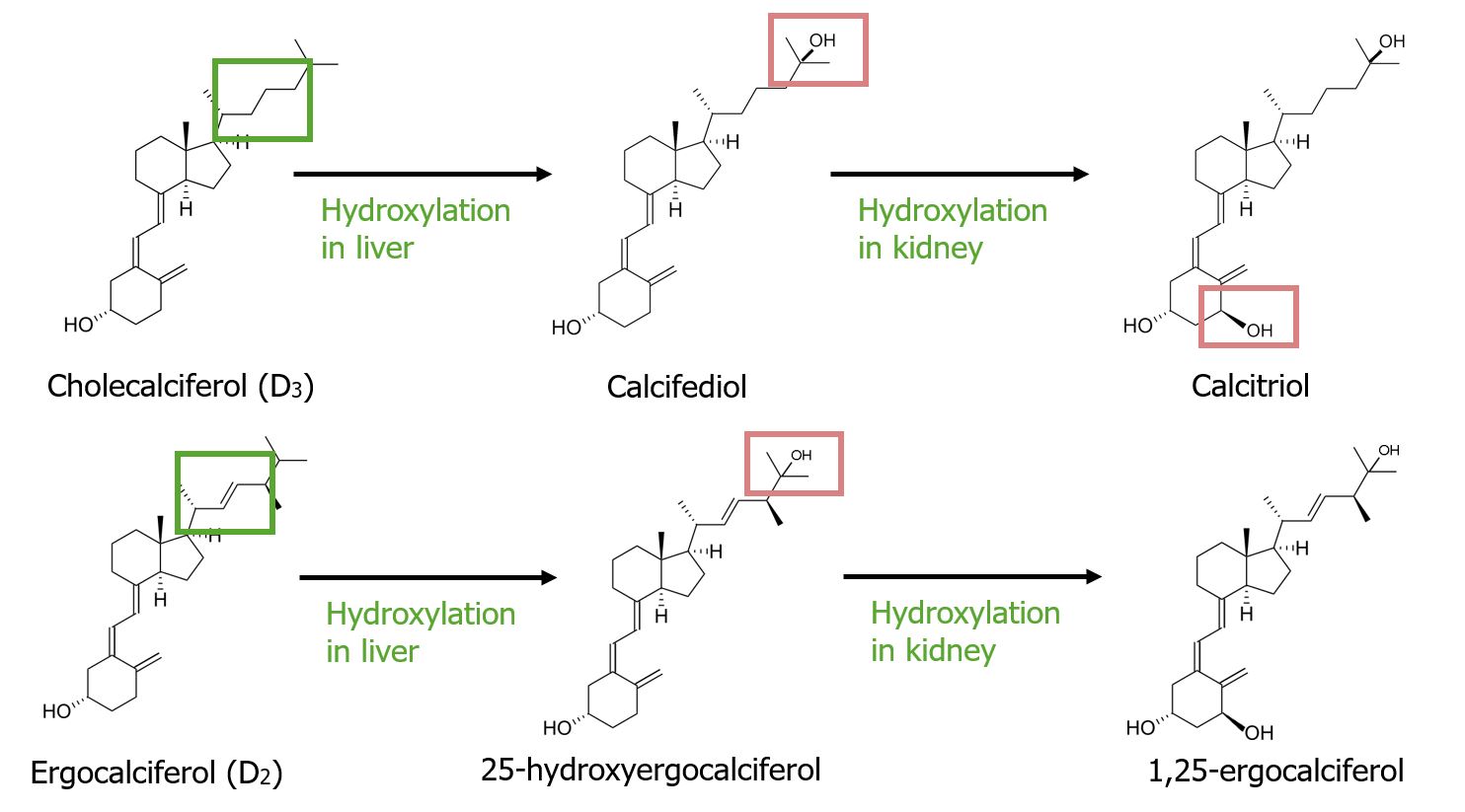Playlist
Show Playlist
Hide Playlist
Introduction to Vitamins
-
Slides IntroductionVitamins Nutrition.pdf
-
Download Lecture Overview
00:00 In this first lecture on vitamins, I'll be introducing you to differences between water soluble and fat soluble vitamins. 00:10 And then we will go on to explore the details of each that you should know for your exams. 00:14 First, we'll take a look at the common features of water soluble vitamins. 00:20 First of all they are hydrophillic. 00:23 Hence, the reason that they are water soluble. 00:26 Which means that we need them only in small amounts and that any excess is going to be excreted in the urine. 00:33 So rarely will we see a toxicity of water soluble vitamins. 00:39 But more likely a deficiency because there are no backup stores in the body. 00:44 The exception to this rule are in vitamin B12 and B9. 00:49 Which are stored in a fairly significant amount in the liver. 00:54 So that they are available for future use. 00:56 So let's take a quick look at all of the vitamins, water soluble vitamins that we'll be covering. 01:04 This is all the Bs as well as the vitamin C. 01:08 And you have names associated with each. 01:11 But let me caution you or let you know that these names and numbers are not things that you need to match together anytime they mention on your exam one or the other. 01:22 Both pieces will be there. 01:24 Of course by the time you are done with learning these vitamins, you probably will know the names as well as the letters associated with them for each. 01:33 Anyway, we will then cover details of fat soluble vitamins. 01:37 Fat soluble vitamins, there are many less of them. 01:40 So much less to handle there. 01:44 They are all hydrophobic and hence the fact that they are fat soluble. 01:50 Again necessary in small amounts. 01:53 Any excess here will be stored in the liver or fat. 01:57 Because they are stored in the liver or fat, we can actually experience toxicities with that soluble vitamins. 02:06 But deficiencies are much less common. 02:10 Because there are generally three to six months worth of storage in the fat and liver tissue. 02:17 So, water soluble vitamins, water soluble, fat soluble vitamins, fat soluble simple enough right. 02:24 Here's how I remember my fat soluble vitamins. 02:29 You can either remember that they are all of the vitamins that are not B and C. 02:35 Or you can remember them as A, K, E and D. 02:40 Again the names are always going to be associated with the letters. 02:47 In the case of fat soluble vitamins, the actual name can change dependent on the form of the particular vitamin. 02:55 For example we might have vitamin D2 or D3. 02:59 D3 is cholecalciferol. 03:02 And the way that I remember these is by imagining a big fat lady laying on the beach, naked. 03:11 So, 'n" we add that in there. 03:13 And then A,K,E and D. 03:15 And I can sort those out. 03:17 Pretty good visual to keep that in mind. 03:20 We use that with students. 03:22 It seems to work. 03:23 So big fat lady is laying on the beach. 03:25 Stuff an "n" infront of it and you've got a naked fat lady laying on the beach. 03:30 Can't include a picture here. 03:32 So, that's all good. 03:33 I'm sure you will keep that in your memory now. 03:36 The key here with absorption for fat soluble vitamins is they are fat soluble. 03:44 And so they are generally going to be bound up in fats. 03:48 Which means that we require pancreatic enzymes in order to absorb them, right. 03:55 They are absorbed via chylomicrons in the small intestine. 03:58 So, any disorder that interferes with pancreatic enzymes will create issues with absorption of fat soluble vitamins. 04:07 Now if you have a decrease in fat absorption, clearly as we covered, you'll have a decrease in fat soluble vitamin absorption. 04:19 Also if you have a decrease in fat absorption, one of the main symptoms is, guess what. 04:28 Well, one of the main symptoms is Steatorrhea. 04:33 Maybe you haven't heard that word. 04:34 Maybe you have. 04:35 But that ends up meaning basically greasy stool. 04:39 So fat in the stool. 04:41 Steatrrohea can result or can be a good indicator that someone may have problems with the pancreas or fat absorption. 04:52 And potentially fat soluble vitamin absorption. 04:58 So oily stool smells really bad. 05:01 Bad symptom to have. 05:03 Anyway, many of the causes of Steatorrhea are here in the table as you can see. 05:09 Most of them relate to the issues with pancreas. 05:14 Or for example with crohn's disease and celiac disease, absorption across the intestine. 05:20 So cystic fibrosis it comes up because with cystic fibrosis we have decrease in fluids. 05:31 So we have the stickiness which actually inhibits the secretion of pancreatic enzymes. 05:36 So that's one of the symptoms also of cystic fibrosis. 05:40 The decrease in fat absorption. 05:42 And so keep in mind that anywhere we're talking about absorption issues. 05:47 We could have a problem with any other vitamins. 05:50 But particularly, any issues of the pancreas, we can have an issue with absorption of fat soluble vitamins. 06:00 So on that note, I would like to share with you an interesting situation. 06:07 You can see in the above image, that fat digestion occurs normally using the enzyme lipase, right. 06:16 Secreted from the pancreas and it breaks the fatty acid chains away. 06:20 There are number of drugs on the market presently for prescribed. 06:24 And over the counter for weight loss, that all fall under the umbrella of orlistat. 06:30 Now what orlistat does is, theoretically cuts the amount of fat absorbed in half. 06:37 And so we see that it interferes with the lipase enzyme and leaves the fats in tact or triglycerides in tact. 06:45 And I bet that you can guess what one of the major side effects of drugs like alli or orlistat are -- well, you've got it, Steatorrhea. 06:56 Not such a great symptom. 06:58 Whether they are effective or not. 07:02 Potentially they are if you see the patients are having increase levels of exercise and reduce caloric intake. 07:10 So they should definitely be prescribed with lifestyle modifications also. 07:16 So in short this was a very brief introduction to the differences between the fat soluble and water soluble vitamins. 07:25 And I look forward to seeing you in the next series of lectures as we highlight all the aspects that you need to know for your exams.
About the Lecture
The lecture Introduction to Vitamins by Georgina Cornwall, PhD is from the course Nutrition. It contains the following chapters:
- Introduction to Vitamins
- Absorption of Fat Soluble Vitamins
Included Quiz Questions
Which of the following vitamins is NOT fat-soluble?
- C
- A
- D
- E
- K
Which of the following vitamins is most likely to lead to toxicity when ingested in large amounts?
- A
- C
- Niacin
- Pyridoxine
- Cobalamin
A patient comes to you with the complaint of foul-smelling greasy stools for the past 6 months. She has no history of melena. Which of the following vitamins would NOT become deficient in this patient?
- Ascorbic acid
- A
- D
- E
- K
What is the major side effect of using orlistat?
- Steatorrhea
- Cardiac block
- Hemorrhage
- Stroke
- Melena
Customer reviews
5,0 of 5 stars
| 5 Stars |
|
5 |
| 4 Stars |
|
0 |
| 3 Stars |
|
0 |
| 2 Stars |
|
0 |
| 1 Star |
|
0 |





